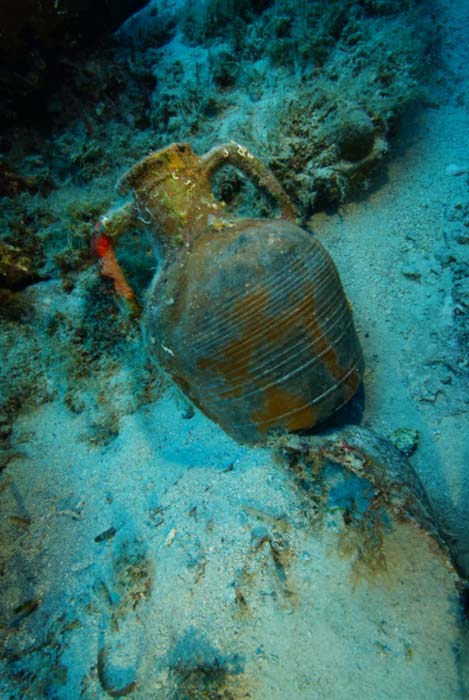
Dozens of Shipwrecks Dating Back Thousands of Years Found in the Aegean Sea
A cluster of Greek islands in the Aegean Sea is giving up some of its deep secrets, as diving archaeologists have now found eight shipwrecks dating back thousands of years. Six Greek and Roman shipwrecks, all Aegean origin cargos, have been discovered so far, revealing patterns of trade during antiquity.
The Fourni Underwater Survey, a joint Greek-American expedition, has previously located an astonishing number of 45 shipwrecks, during their survey around Fourni. Now, the divers can add another 8 wrecks to this hotspot for sunken ships, bringing the total number to 53 shipwrecks discovered in Fourni, making it the largest concentration of shipwrecks currently known in the Mediterranean.

Archaeologists and the ROV robot work to recover an ancient North African amphora by Vasilis Mentogianis

A Late Roman amphora on the seafloor by Vasilis Mentogianis
Tempestuous Fourni
Fourni, which is composed of 13 small islands and islets between the large Aegean islands of Samos and Icaria, was critical for navigation since Samos and Ikaria created a choke point that made ships have to pass through Fourni. This resulted in a high volume of maritime traffic as it was known by mariners as a good anchorage on their trade route that went both east to west and north to south.
Ships would have anchored in spots that were protected from the usual northwest winds. But once in a while, the mariners could be caught off guard by a big southern storm. If the position of the ships anchor wasn't changed fast enough, these ships would be in trouble and crash against the rocks. Those are the misfortunate ships that are now being discovered by the diving archaeologists.
Merchants in the Mediterranean
Nearly all the ships discovered are amphora-carrying vessels, so merchant ships. In some cases, a wreck's cargo had a clear origin, such as a set of amphoras from the Greek island of Chios dating back to the Classical period (510-323 BC) and a Hellenistic-era amphoras (331-323 BC) from the Greek island of Kos. In other cases, amphoras have been identified from Italy, North Africa, Cyprus, Egypt, Spain and elsewhere. In addition to the amphoras, which served as the delivery containers of the ancient world, the divers discovered lamps, cooking pots and anchors.
The dates of the shipwrecks range from the late Greek Archaic period (525-480 BC) to the Early Modern period (1750-1850 AD).

3D model of a Roman period shipwreck by Kotaro Yamafune

Photographing large Pontic amphoras that date to the Roman Period by Vasilis Mentogianis
More Awaits Discovery
There could be more to explore at Fourni: there are historical accounts of a 17 th century French shipwreck in one of the bays and a British aircraft in the Sea near Fourni during World War II. So far, the team have covered less than half of the archipelago's total coastline in their surveys.
The deepest dives of the survey went to 65 meters, but there is probably more to discover below that level, given how steep the cliffs are.

The chief conservator carefully prepares a Classical Period Chian amphora for the conservation tank by Vasilis Mentogianis
This season primary focus was on documentation of the ships found previously. RPM Nautical Foundation's research vessel Hercules used its remote sensing equipment and ROV to assist in the survey and documentation of the shipwrecks. The project selected artifacts from sites to recover for conservation and scientific analysis, which may reveal further information about trade and exchange.
In the next phase of the project, the team hopes to go even deeper with technology such as remotely operated underwater vehicles.
Top image: An archaeologist systematic photographs a wreck site to create a 3D site plan by Vasilis Mentogiani.
By Sam Bostrom















